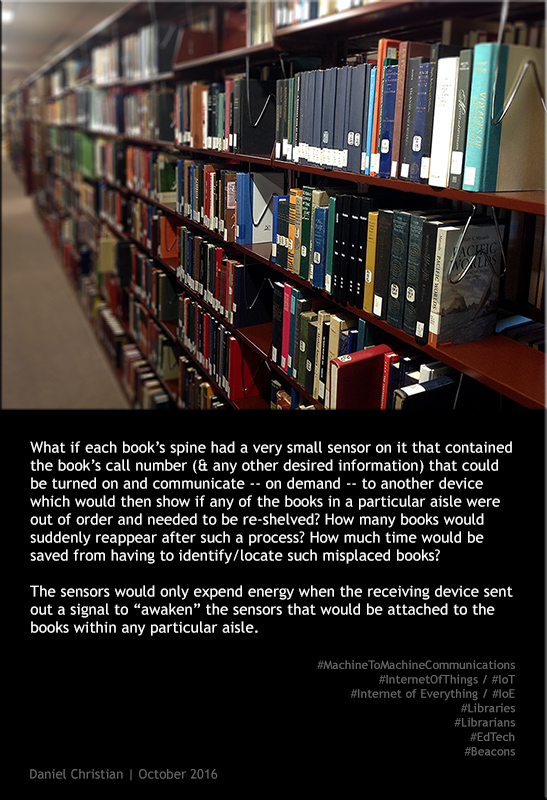From DSC:
Here’s an idea that came to my mind the other day as I was walking by a person who was trying to put some books back onto the shelves within our library.

From DSC:
Perhaps this idea is not very timely…as many collections of books will likely continue to be digitized and made available electronically. But preservation is still a goal for many libraries out there.
Also see:
IoT and the Campus of Things — from er.educause.edu by
Excerpt:
Today, the IoT sits at the peak of Gartner’s Hype Cycle. It’s probably not surprising that industry is abuzz with the promise of streaming sensor data. The oft quoted “50 billion connected devices by 2020!” has become a rallying cry for technology analysts, chip vendors, network providers, and other proponents of a deeply connected, communicating world. What is surprising is that academia has been relatively slow to join the parade, particularly when the potential impacts are so exciting. Like most organizations that manage significant facilities, universities stand to benefit by adopting the IoT as part of their management strategy. The IoT also affords new opportunities to improve the customer experience. For universities, this means the ability to provide new student services and improve on those already offered. Perhaps most surprisingly, the IoT represents an opportunity to better engage a diverse student base in computer science and engineering, and to amplify these programs through meaningful interdisciplinary collaboration.
…
The potential benefits of the IoT to the academic community extend beyond facilities management to improving our students’ experience. The lowest hanging fruit can be harvested by adapting some of the smart city applications that have emerged. What student hasn’t shown up late to class after circling the parking lot looking for a space? Ask any student at a major university if it would improve their campus experience to be able to check on their smart phones which parking spots were available. The answer will be a resounding “yes!” and there’s nothing futuristic about it. IoT parking management systems are commercially available through a number of vendors. This same type of technology can be adapted to enable students to find open meeting rooms, computer facilities, or café seating. What might be really exciting for students living in campus dormitories: A guarantee that they’ll never walk down three flights of stairs balancing two loads of dirty laundry to find that none of the washing machines are available. On many campuses, the washing machines are already network-connected to support electronic payment; availability reporting is a straightforward extension.
Also see:
2016 Innovators Awards | A Location-Aware App for Exploring the Library — from campustechnology.com by Meg Lloyd
To help users access rich information resources on campus, the University of Oklahoma Libraries created a mobile app with location-based navigation and “hyperlocal” content.

Category: Education Futurists
Institution: University of Oklahoma
Project: OU Libraries NavApp
Project lead: Matt Cook, emerging technologies librarian
Tech lineup: Aruba, Meridian, RFIP
Somewhat related:
- What is beacon technology and why it’s here to stay — from by sixteen-nine.net








